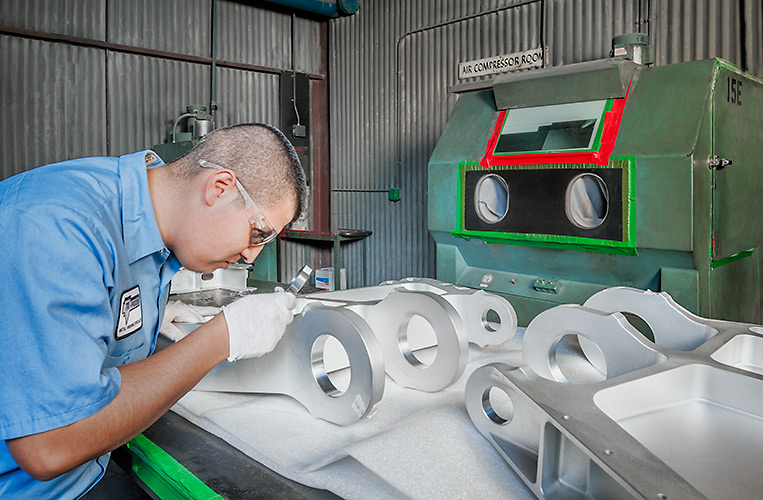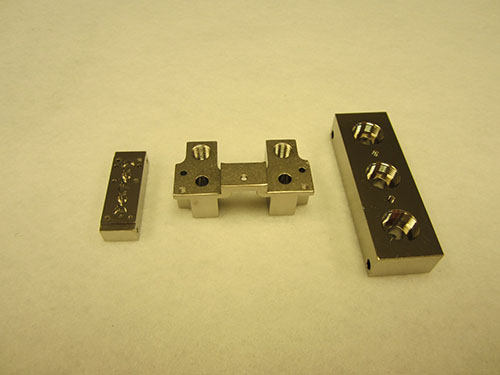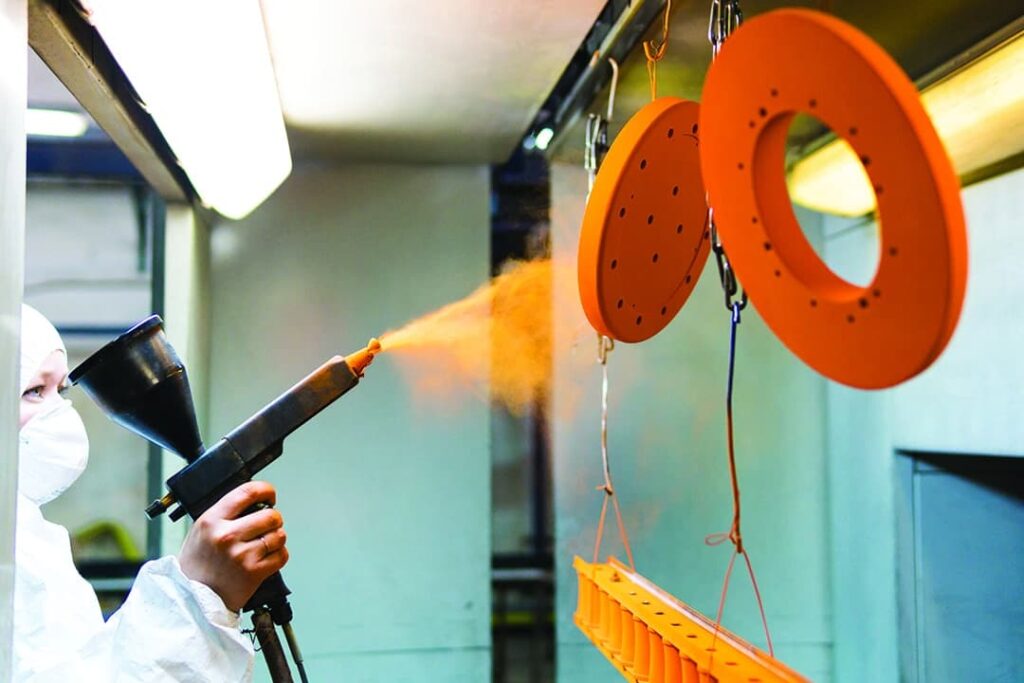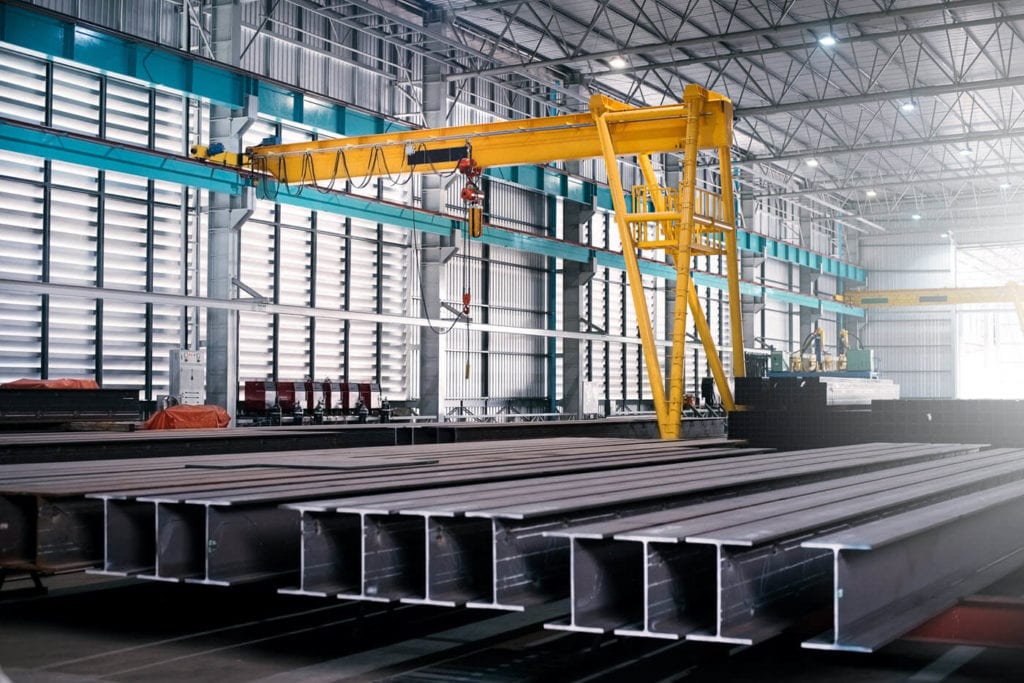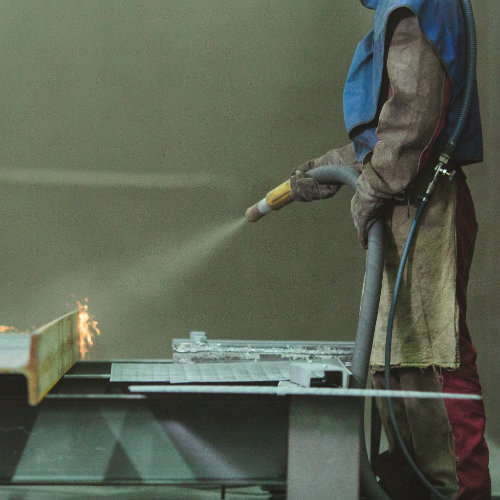Important design and structural uses for metals like steel, titanium, aluminum, etc., can be found in engineering. This is due to their desirable qualities, which enable them to perform well when used in diverse applications.
However, the majority of these metals are used in demanding service environments, which gradually erodes their characteristics and negatively impacts their performance in service. For instance, steel is used in the aerospace sector as one application. This puts it in a very hostile, corrosive environment where it might corrode and eventually sustain damage. The damages in this application go beyond just aesthetic or cosmetic concerns and will erode the steel’s structural strength. These damages could necessitate more frequent replacements and more expensive upkeep.
Surface plating is the process that adds the surface layer of a metal to another type of metal. Hence the metal added forms a protective shield to the base metal.
In this article, we will discuss what surface plating is, how the plating works, why surface finishing is important, etc.
Key Takeaways
- Surface plating is the process that adds the surface layer of a metal to another type of metal.
- It is primarily done to prevent corrosion, enhance solderability, improve the hardness of the substrate, reduce friction between moving parts, enhance infrared (IR) reflectivity, shield against radiation, and improve the overall aesthetic appearance of the metal component.
- Electroplating, Electroless plating, and immersion plating are key surface plating techniques used in various industries, including business aviation, commercial aviation, defense, medical/life sciences, and space and communication systems.
What Is Surface Plating?
Plating can be described as the surface covering where metal is deposited on a conductive surface. Without metal plating, corrosive raw metals would only last a fraction of their potential coated lifespan. Depositing a long-lasting, hard, and corrosion-resistant surface on top of the functional metal of the part will help the product resist abrasion and corrosion.
The typical method involves submerging the metal in an acid solution along with a cathode and anode electric current. A direct electric current is passed through the material to be plated, which serves as the cathode (negative electrode) of an electrolysis cell.
The needed metal is present in the solution or bath in an oxidized state (either as a complex ion or an aquated cation).Typically, a bar of metal being plated serves as the anode.
Differences Between Coating And Plating
Coating can be done on both conductive and non-conductive surfaces, whereas plating can only be done on conducting surfaces. This is the main distinction between coating and plating. However, in differentiating between these two techniques, it is important that we establish their definitions.
Plating
Plating is a type of coating in which a metal is deposited on a conductive surface. Humans have employed this method from the beginning of time, and modern technology also makes use of it. The goal of plating can be aesthetic, prevent corrosion, improve solderability, harden, reduce friction, change conductivity, improve IR reflectivity, shield against radiation, etc.
Coating
Coating is covering the surface of an object. The object that is being coated is usually referred to as the substrate. Coating is important for decorative purposes, functional purposes, or for both. For example, paints and lacquers are important in protecting the surface of a substrate and also for decorative purposes. The functional properties of coating include adhesion, wettability, corrosion resistance, wear resistance, etc. Coating can completely cover the object or only some parts of the object.
Difference Between Coating And Plating
Coating and plating are techniques of surface covering. Coating can be done on both conductive and non-conductive surfaces, whereas plating can only be done on conducting surfaces. This is the main distinction between coating and plating. Furthermore, plating entails applying a metal to a surface using an external electric current or a number of simultaneous reactions, whereas coating can be done using inexpensive technology or simple techniques like brushes.
Types Of Plating And Their Effects
The types of plating and their effects include:
Electroplating
The most commonly used plating technique is electroplating. In the process of electroplating, positively charged metal ions are dissolved in a chemical solution. The material that is going to be plated, which is on the negatively charged side of the circuit, is drawn to the positively charged metal ions.
The dissolved metal particles are then attracted to the surface of the component or finished good after it is submerged in this solution. The surface of the material is successfully changed by electroplating, which produces a smooth, even, and quick coating for the substance.
Cleaning, striking, electrochemical deposition, pulse electroplating, and brush electroplating are just a few of the several phases and procedures that can be used in electroplating.
Effects Of Electroplating
A protective coating, a decorative finish, or a modification in a material’s qualities can all be achieved through electroplating. Electroplating improves the chemical, physical, and mechanical properties of the workpiece, which affects the way it performs when machined. The workpiece can be built up from a smaller size, made easier to process, and its solderability, conductivity, or reflectivity can all be improved by plating.
Electroless Plating
Electroless plating is so-called because it is a plating method that does not use external electric power. Electroless plating involves a chemical reaction that facilitates metal atom reduction. In other words, when metal ions (particles) in a reducing agent solution come into touch with the catalytic metal, they are transformed into a metal solid (which triggers the reaction). As a result, a thick layer of the plating metal is applied to the metal.
Electroless Plating Effects
Because electroless plating doesn’t require external power or plating baths and may be used on a variety of sizes and shapes of materials, it is less expensive. Electroless plating is slower than electroplating, unable to produce thick plates, and more difficult to regulate. Electroless nickel plating is the most typical autocatalytic plating technique. However, this method can also be used to apply copper, silver, and gold plating.
Electroless plating has a number of effects on the finished product, including preventing corrosion of the base metal, enlarging the workpiece, and changing conductivity, reflectivity, and solderability.
Immersion Plating
One metal is immersed in a solution of metal ions from a more noble metal during immersion plating. A natural “pull” occurs to replace the surface metal ions from the less noble metal with a thin coating of the more noble metal ions because the ions from the nobler metal are more stable. Immersion plating takes longer and is limited to coating more noble metals with less noble metals. Metals that are chemically inert are considered noble metals. Silver, platinum, or gold are a few examples.
Immersion Plating Effects
Immersion plating produces a thin layer of plating that is followed by the plating process ceasing. Additionally, immersion plating appears to have lower adhesion quality, where the plating doesn’t’ stick to the base metal as securely.
Immersion plating has a positive impact on the final product’s corrosion resistance, electrical conductivity, aesthetics, hardness, torque tolerance, and bonding properties.
How Does The Plating Process Work?
Here, we will be describing how the electrolytic plating process works through electroplating. One finishing technique that finds use in numerous sectors is electroplating. The characteristics and appearance of parts are enhanced by this technique. Originally, metals could only be improved by electroplating them with other metals, but recent technological advancements have made it possible to do the same with non-metals.
Additionally, electroplating allows the beneficial qualities of some metals to be combined with other substances. Strength, abrasion resistance, aesthetic appeal, corrosion resistance, and electrical conductivity are a few of these characteristics. The technique also seeks to enhance or improve the material’s characteristics. It could be made of plastic, wood, or metal. Aside from this information above, how does electroplating work? Which kind of metal is best to use in this process? What are the pros and cons of this plating procedure? Continue reading to get the answers to these and other crucial details regarding the electroplating procedure.
Electroplating works by dissolving and depositing a metal onto another surface through an electric current. There are four primary components of this process.
Anode
This is the circuit’s positively charged electrode. The metal required for plating is stored in the anode.
Cathode
This is the circuit’s negatively charged electrode. It contains the substrate, which is the substance you wish to plate.
Plating Solution
One of the most significant methods for metal finishing is this. It acts as a catalyst, promoting the movement of electricity through the circuit. Typically, copper sulfate and one or more metal salts are present in the plating solution.
Power Source
Current is added to the circuit by the power supply. When the power source is connected to the anode, electricity is introduced into the system.
Electroplating Working Principle
So, how exactly does electroplating work? Below are the steps of electroplating.
Put the cathode (substrate) and anode (metal) in the electrolyte or plating solution. Next, connect the setup to an electrical source using the anode.
As a result, oxidation occurs when electricity is applied to the anode. As a result, metal atoms dissolve as positive ions in the plating solution (cations). Additionally, the metal ions (positively charged ions) flow from the circuit’s current to the negatively charged substrate. As a result, a thin metal coating is deposited on the substrate.
Additionally, keep in mind the following points to ensure the success of the electroplating procedure. First, the plating procedure is impacted by the quality of the electric current. Voltage level and electric current application time are examples of quality in this context.
Second, the process efficiency is also influenced by the electrolyte’s temperature and chemical makeup. Last but not least, constantly think about how close the anode is to the cathode. This is because the efficiency of plating is also influenced by how far the dissolved metal ions must travel to reach the substrate.
Three Types Of Electroplating Methods
There are different types of electroplating methods to employ when coating a substrate. These include:
- Barrel Plating
- Rack Plating
- Reel to Reel Plating
Let us discuss these methods in more detail with:
Barrel Plating
This rotation causes the substrate inside the barrel to tumble, which makes it easier to apply the coating metal uniformly. Therefore, engineers adopt this type to create a superior substrate appearance and enhanced corrosion resistance. Similarly, engineers can increase a substrate’s resistance to wear and strain by barrel plating.
Additionally, it offers a less expensive way to plate large quantities of parts because it permits the insertion of more than one substrate inside the barrel. For plating fasteners and stampings, barrel plating is the best option. On the other hand, because this process uses a modest electrical current, plating takes longer with this approach.
Rack Plating
Barrel plating is different from rack plating. Substrates remain stationary in this case. Barrel plating’s process does not permit the same degree of mobility. Additionally, it calls for the use of metal racks, to which the substrates are fastened using spring fingers, wires, or screws. As a result, even after being submerged in the electrolyte, the substrate doesn’t move.
In addition, it’s crucial to remember that engineers use rack plating when dealing with fragile parts. To put it another way, parts might not be able to resist the jarring process of barrel plating.
Reel-to-reel plating is efficient and cost-effective. Because it enables the selective deposition of metals on a substrate, it is a special plating technique. Reel-to-reel plating is more advantageous to engineers than other plating techniques and is frequently used for coating strips of produced or pressed goods. There is also:
- Controlled Depth Plating – Only the substrate’s two edges get plated. It only happens here, nowhere else.
- Spot Plating – This reel-to-reel plating method requires the use of a mask. Here, metal accumulation only happens in spots and uncovered areas.
- Flat Stock – This technique, which includes depositing metal on exposed portions of a substrate, is comparable to spot plating.
Tape Masking Plating
The continuous strip of metal is deposited on the substrate using this reel-to-reel plating technique. It is crucial to remember that you should use masking tape to cover any sections that don’t need plating.
In general, reel-to-reel plating is the best method to utilize when you wish to plate a specific area of the substrate. It also has a high plating rate and gives substrates improved conductivity and durability. This technique results in durable, corrosion-resistant materials plating. Additionally, this plating technique reduces costs when applied to high-volume jobs.
Why Is Surface Finish Important?
Nowadays, parts made from common alloys like steel can be specified with an impressive number of surface coatings and treatment options. More kinds of materials are now suitable for surface treatments as material coating deposition methods advance and become more commercially viable. The development of direct energy techniques like electron and laser beam processes, along with improvements in physical and chemical vapor deposition procedures, have opened up new options for a variety of coating parameters. Indeed, there are many different uses for surface coatings, ranging from simple ones like hot-dipped zinc coatings, which offer excellent protection for the steel against atmospheric corrosion, to considerably more complex ones like the nanocrystalline diamond coatings used to make incredibly hard-faced cutting tools.
A surface coating can enhance the performance of a part or mechanical subsystem in a variety of common functional mechanical applications. The list of mechanical applications that would considerably benefit from the addition of extra surface coatings is briefly examined below, along with a few concrete examples of cost-effective coatings that may be used.
Wear Resistance And Friction Performance
For mechanical applications where mating parts move against each other under high loads, such as shaft/bushing pairs, the mating surfaces of each will typically be coated or treated to increase the hardness of the mating surfaces, thereby improving wear resistance. Surface wear and damage can be very dangerous for these kinds of parts. If left unchecked, this can occasionally result in material failure as a result of cracks that start on the surfaces of the matching pieces.
In these kinds of applications, thermal spray coating treatments with chromium nitride (CrN) are frequently used, and more complicated surface treatments with alloys like nickel-chromium-boron (NiCrB) can also be applied to a surface where there are high loads, and component performance is crucial.
Additionally, friction between the parts needs to be carefully managed when running speed is a functional concern. Surface treatments used solely to increase wear resistance frequently have the additional benefit of reducing friction between the two mating parts.
To ensure the least amount of friction between the parts, these coatings (which commonly use an electroless nickel plating procedure) produce an outstanding polish with extremely low surface roughness values. This is likely the most frequent justification for calling for a surface treatment like electroless nickel plating.
Corrosion/Oxidation Resistance
When a component is deployed in a chemically hostile environment, protecting the surface from corrosion or chemical damage is another frequent reason for specifying a surface treatment on the component. The most popular method of surface protection against corrosion involves hot-dip zinc plating, which coats the base metal and uses highly reactive zinc (Zn) to erode sacrificially when the barrier is scratched or otherwise compromised, protecting the base material.
To obtain a comparable level of corrosion protection, a variety of additional full-coverage coating techniques, such as thermal-spray coating procedures, can be specified.
Other Applications
Other, more specific applications, such as those requiring heat protection or material diffusion resistance in a saturated environment, would benefit tremendously from a surface treatment.
These common applications ought to offer a few fundamental building blocks for figuring out whether a specific application would profit from a surface coating treatment. When deciding what coating material or technique should be specified on crucial subcomponents, the engineer should pay special attention to the desired operating environment, designed load capacity, and/or operating speed for each individual application. It’s likely that a surface treatment has been created particularly to help allay these worries.
Surface Plating Finishing Types Coating Services
Valence is the only independent surface finishing company to offer a full suite of integrated finishing solutions strategically located to support commercial, military, and satellite manufacturing hubs across the United States. The following are surface plating and finishing types around today.
Powder Coating And Liquid Coating
In powder coating, dry powder is electrostatically deposited first, and then the metal component is heated at high temperatures to “melt” the flakes and fuse them to the metal surface. The powder coating method is used by Source in a variety of products, including furniture, cars, farm equipment, electrical equipment, sports equipment, and more.
As the name suggests, a liquid paint or coating material may be applied via a variety of methods, including electrostatic, dipping, brushing, and spraying.
Electroplating, Galvanizing, And Anodizing
The different electroplating processes all use electricity to run an electric current through a liquid bath to coat metals. The substrate is the substance being treated, while the bath is a solution containing the metal ions that are being added. The substrate serves as a cathode when the electric current is applied. As a result, the ions in the bath that are deposited on the treated surface are drawn to it.
Increased durability, higher corrosion resistance, decreased surface friction, and improved aesthetics are just a few of the benefits this procedure offers. Almost any metal can be treated using this method. However, zinc, copper, nickel, gold, silver, and other metals are the most frequently used ones.
Sanding/Sandblasting/Polishing/Lapping/Grinding
These surface finishing operations are typically still carried out manually, which calls for only a few basic tools and pieces of equipment in the hands of highly skilled employees. Recent improvements in automation have reduced the need for human labor and increased output uniformity and reliability. These procedures use various machining techniques referred to as abrasive machining to remove a layer from the surface or reshape it.
This method is used to remove blemishes from the metal’s surface, whether they are dry or wet (using oils, water, or other liquids). Aluminum, brass, cast iron, carbon steel, and stainless steel are typical metals that need to be machined using abrasive techniques. Lapping is frequently used to create optical lenses, bearings, gauges, and other items where fine finishes and high precision are required.
Electropolishing
Since both processes involve electricity and chemical reactions, electropolishing and electroplating are comparable. However, in electropolishing, ions are removed from the surface being treated rather than added, as in electroplating. To deburr and reduce the average surface roughness and produce an even, smooth, and clean surface free of imperfections, electropolishing is frequently employed.
Stainless steel, aluminum, copper, titanium, nickel, and copper alloys are among common metals that undergo electropolishing (particularly when used in the culinary, medical, and pharmaceutical industries).
Let Valence Help You
Looking to talk to an expert on plating or finishing-related topics? Let Valence help you. Valence is the industry leader in quality for precision components in the aerospace, satellite, electronics, and medical device industries. With unique selective plating and precision masking techniques for critical plated components, we are the leader in satellite and UAV applications, including a proprietary process for the precision internal plating of waveguides.
We offer integrated honing and grinding capabilities to complement our cadmium and chrome plating. To get a quote on your next project, get in touch with us today and we’ll discuss all of the surface finishing questions you may have.
Sources:
- Manager, I. C. (n.d.). Surface Treatment of Metals. Www.iloencyclopaedia.org. https://www.iloencyclopaedia.org/part-xiii-12343/metal-processing-and-metal-working-industry/item/684-surface-treatment-of-metals.
- Electroplating – an overview | ScienceDirect Topics. (n.d.). Www.sciencedirect.com. https://www.sciencedirect.com/topics/materials-science/electroplating
- Centers for Disease Control and Prevention. (2019, June 21). Hexavalent chromium. Centers for Disease Control and Prevention. https://www.cdc.gov/niosh/topics/hexchrom/default.html#:~:text=Hexavalent%20chromium%20is%20harmful%20to,from%20exposure%20to%20hexavalent%20chromium.
FAQs
What are the different types of surface treatments on metals?
Common surface treatments include anodizing, electroplating, conversion coating, polishing, and painting.
Why do materials need surface treatment?
Surface treatments are often used to improve the performance and durability of a material.
What is the difference between surface treatment and coating?
With surface treatment, the outermost layer of the material is metallurgically modified. Coating, on the other hand, does not affect the properties of the base material when applied over.
How thick is surface treatment?
The thickness of a surface treatment depends on the specific treatment method and the desired outcome. In some cases, surface treatments can be very thin, measuring only a few microns, while in other cases, they can be several millimeters thick.
Why does steel need a finish or surface treatment application?
Steel is a highly reactive material, so it is prone to corrosion and wear. Applying a finish or surface treatment to steel can help protect it from corrosion and wear.
What is the purpose of surface coating?
Surface coating is a process used to modify the surface of a material. Common uses for surface coating include improving the corrosion resistance, wear resistance, and aesthetic appearance of a material.
What is surface protection of metals?
Surface protection of metals is a process used to protect the surface of a metal from corrosion and wear. Common surface protection methods include anodizing, electroplating, and painting.
What is the best surface coating process?
There is no one-size-fits-all answer to this question, as different coating processes have distinct advantages and limitations.
The selection of the best coating process involves considering factors such as the desired properties of the coating (such as corrosion resistance, hardness, or lubricity), the substrate material, cost, environmental impact, and application method.
What is surface treatment preparation?
Surface treatment preparation refers to the steps taken before applying a surface treatment to a material. It involves preparing the surface by cleaning, degreasing, and sometimes etching or roughening it to ensure proper adhesion of the treatment.
